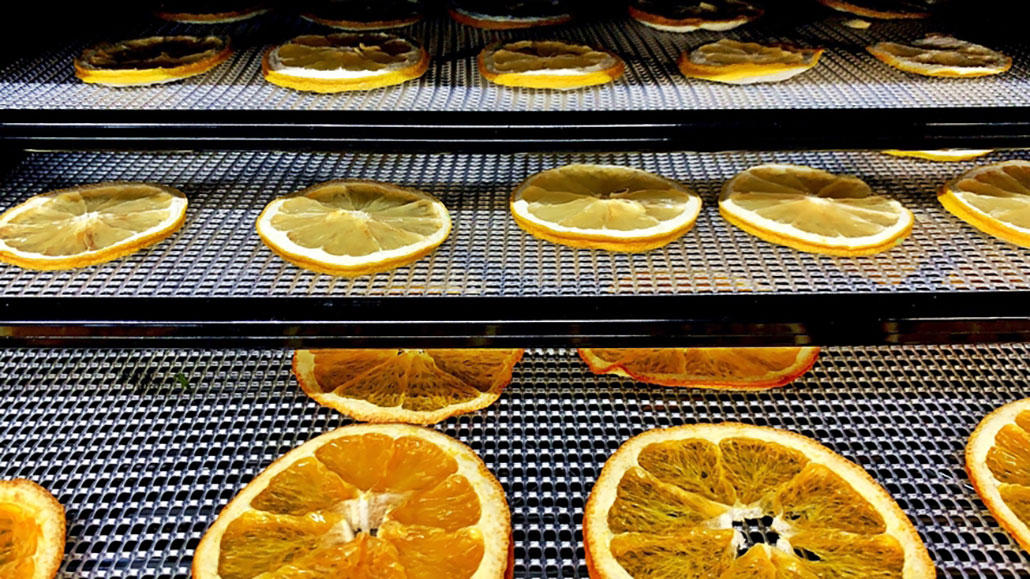New ‘ionic wind’ can dry foods while preserving nutrients
This no-heat technique halves drying time and really cuts the energy required

Researchers have improved a way to dry vegetables or fruit (like orange slices here) without heat. The energy-efficient process relies on a slow, electrically driven “breeze.”
Empa
By Sid Perkins
Once a piece of fruit or a vegetable is picked, it starts to go bad. One common way to slow or stop that spoilage is to remove water from the food. That process — dehydration — typically involves heat. But heat can destroy a food’s nutrients. Now, researchers have come up with a more energy-efficient way to dehydrate food without heat. It could help keep dried fruits and veggies more wholesome and more flavorful, they say.
Foods are full of delicate chemicals. These include vitamins, which the human body can’t produce on its own. Others are antioxidants. They interfere with reactions inside cells that can cause disease. Still other chemicals lend flavor. All of these can be damaged or destroyed by heat, says Kamran Iranshahi. He’s a mechanical engineer at the Swiss Federal Laboratories for Materials Science and Technology. It is based in St. Gallen.
A common way to dry sliced fruits and veggies is to blow hot air across them. But there’s another way to get air moving, notes Iranshahi. And it doesn’t need a fan or heat. It only takes metal wires and a good bit of voltage.
Called “ionic wind,” this technique had never seemed ready for prime time. For starters, it used a lot of energy. It also took too long to dry things. So the St. Gallen team began tweaking the process. And this delivered a lot of benefits. For instance, it halved the time ionic winds need to dry produce.
How it works
Ionic wind is generated by electricity. When you apply a high enough voltage to a bare, positively-charged wire, it will create an electrical field. That field will strip electrons from nearby air molecules. Usually, between 10,000 and 30,000 volts will suffice, says Iranshahi.
Because electrons have a negative charge, they will be attracted to the wire. Meanwhile, air molecules that lost electrons are now positively charged. That wire will now repel them at very high speed. As those charged particles — or ions — move, they’ll bump into uncharged air molecules and start dragging them in the same direction. This sets up the ionic wind.
In previous versions of the set-up, the fruit and veggies to be dried rested on a metal plate. Because airflow never reached the underside of the produce, those pieces dried rather slowly. Iranshahi’s group has now substituted a metal mesh for the plate. That seemingly small change appears to have made a big difference. Using it, the Swiss team has not only cut the drying time, but in the team’s latest tests it also has dropped the energy use by more than 85 percent!
The researchers describe their improvements in the October 1 Energy.
Previously, ionic wind drying has worked only on a small scale, says Iranshahi. It was way too costly to dry large volumes of food.
“It’s amazing,” says Vijaya Raghavan of the new findings. He’s a mechanical engineer at McGill University in Montreal, Canada.
“People considered the [hot air] drying process as good enough for many, many years,” Raghavan notes. “But now, more and more people are worried about the health . . . of their foods,” he notes. The Swiss team’s impressive innovations, he says, may now make it easier to scale up the ionic wind process to deliver healthy and flavorful dried foods.
The previous version of ionic wind, which rested produce on a metal plate, was about 95 percent more energy efficient than drying that food with air moved by a fan. The newer mesh design should be even more energy efficient, Iranshahi says. So far, few studies have assessed the nutrient content of produce dried with ionic winds. However, Iranshahi notes, the new technique should destroy fewer nutrients than heat-based methods.
This is one in a series presenting news on technology and innovation, made possible with generous support from the Lemelson Foundation.







